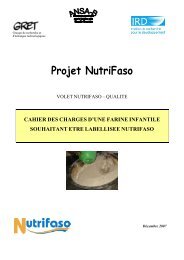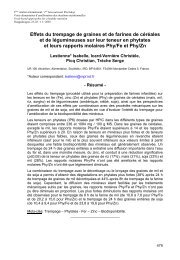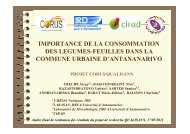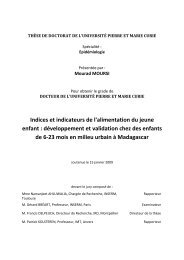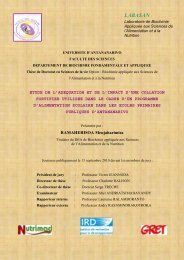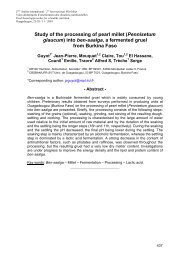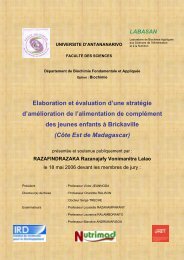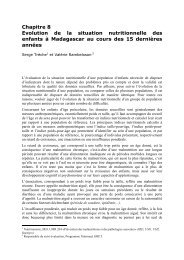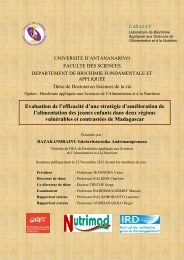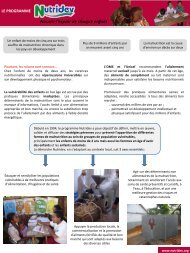THESE UNIQUE El Hassane Kéhien-Piho TOU - Nutridev
THESE UNIQUE El Hassane Kéhien-Piho TOU - Nutridev
THESE UNIQUE El Hassane Kéhien-Piho TOU - Nutridev
You also want an ePaper? Increase the reach of your titles
YUMPU automatically turns print PDFs into web optimized ePapers that Google loves.
Projet d’article<br />
saalga (Tou et al., 2006) showed that it had a<br />
low pH (4.0 ± 0.4), low energy density (about<br />
30 kcal/100g of gruel). In ben-saalga<br />
processing method, two fermentation steps<br />
were observed. The first occurred during<br />
soaking of the grains and the second during<br />
the settling step. Soaking was characterised<br />
by an alcoholic fermentation whereas, a lactic<br />
acid fermentation occurred during settling.<br />
Ben-saalga microbiota was dominated by<br />
lactic acid bacteria (LAB) with an<br />
ALAB/LAB ratio of 12% (Tou et al., 2006).<br />
If information is available concerning the<br />
bacteriocinogenic activity of Lactobacillus<br />
plantarum strains isolated from ben-saalga<br />
(Ben Omar et al, 2006), however, no general<br />
description is available about the lactic acid<br />
bacteria involved in the processing of bensaalga.<br />
Information about the<br />
microorganisms involved in indigenous foods<br />
is essential because they specially contribute<br />
to improve the stability and properties of<br />
these foods.<br />
The aim of the current work was to isolate<br />
and characterize the lactic acid bacteria<br />
involved in ben-saalga processing method.<br />
Lactic acid bacteria of ben-saalga were<br />
characterized according to their phenotypic<br />
characteristics (morphology, Gram reaction,<br />
catalase activity, biochemical profiles by API<br />
50 CHL strips and metabolic type by HPLC).<br />
2. Materials and methods<br />
2.1. Numeration and isolation of bacterial<br />
strains<br />
Among a list of 93 traditional producing units<br />
(TPU) identified during a preliminary survey<br />
carried out in Ouagadougou (Djossou et al,<br />
1999), 12 TPUs of fermented gruels (bensaalga<br />
or ben-kida) have been randomly<br />
selected. Fermented pastes were taken<br />
aseptically in these 12 TPUs at the end of the<br />
fermentation step. Samples were conserved at<br />
+4°C before their analyses which were<br />
performed the same day. Medium of de Man,<br />
Rogosa and Sharpe (MRS, Difco) was used<br />
to isolate lactic acid bacteria (LAB) strains<br />
from these samples of fermented pastes.<br />
MRS-agar was used for numeration and<br />
isolation and MRS-broth media for routine<br />
culture.<br />
Strains were stored in glycerol (40%) at -<br />
80°C. For use in biochemical tests, a 24h<br />
culture of each strain was centrifuged<br />
(SGMA, 4K10) at 10000 rpm for 5 min and<br />
the pellet was washed three times in sterilised<br />
physiological water (9 g NaCl/l).<br />
2.2. Phenotypic characterization of bacterial<br />
strains<br />
The isolated strains were tested according to<br />
their phenotypic characteristics: morphology,<br />
Gram reaction, catalase activity, biochemical<br />
74



